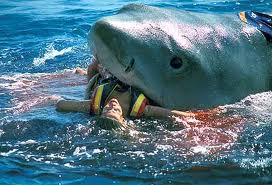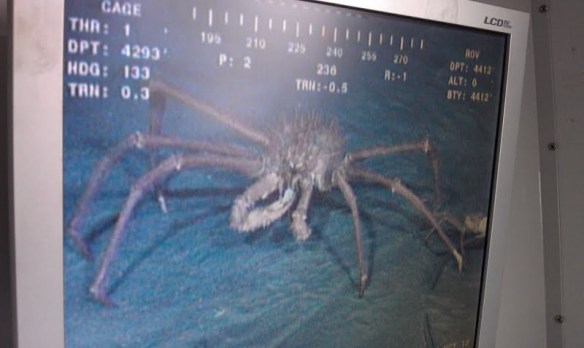A foreign world lurks under the surface. Initially, I wrote this post as a theme on how to get to oil and produce it…. However, it has evolved into a theme of steps you must go through to survive the elements, be them environmental, personal, economic, or political.
Level 1: The Water
The treacherous Gulf extends its depth to over a mile in some places. Sharks and Barracuda patrol the waters as ships travel to and from locations. Helicopters come populate the ships with people. The large vessels are equipped with extensive machinery to not only navigate to a spot, but use dynamic positioning to stay on a point within a 10m window. They include personnel accommodations, catering, cleaning, and maintenance staff.
Level 2: The Gates
The sea floor is guarded by crabs, such as the one pictured below. This spider crab was spotted by the ROV (remote operated vehicle) on the Discoverer Enterprise. When on a ship, there are cameras which feed to the TV’s on the rig. This photo was taken off the television screen from the ROV channel.
Once marine riser is put into place, drill pipe breaks ground and begins drilling. The BOP (Blow Out Preventers) is installed above the sea floor.
Level 3: Journey to the Center of the Earth
While drilling, or doing anything in a well, the pressures must balance out. For example, the pressure built up in the earth must be equalized by the fluid column which is in the well. On this last job, the rig shot holes through casings into a salt zone. The salt zone is of lower pressure, and consequently, began “taking” fluid from the well. To contain the well, the rig circulated out 12 lb/gal mud in the fluid column with ordinary sea water. Such issues are of grave concern and arise at every step in drilling, completing, producing, working over, and eventually abandoning a well.
Level 4: The Faithful Crew
I was recently in a rig meeting with the oil company, third-party service hands, and the drilling company. To conclude the meeting, the wellsite leader looked up from his notes and stated, “One rig, one team”, reminding everyone involved that this project is not about serving the letters embroidered on your flame retardant coveralls. All the interworkings and complex systems on a rig are striving for the same project. Ultimately, the crew’s health and safety should be a uniting factor. On another job, I met a third-party hand who was the rig health and wellness coach. She counselled people on the rig about their eating and exercise habits, as well as conducted health screenings, cholesterol and blood pressure tests. This was amazing to me. Hundreds of people work two weeks at a time, often risking their health, to make a living. We all work together to make the job as safe as possible.
Level 5: The “Man”
I’ve been working for BP a lot these last few months. While this has mostly entailed taking a “random” alcohol and drug screening every week and a half, it has sparked my ears to talks of political discourse. You must tread lightly and not bite the hand that feeds…. After the Deepwater Horizon blowout in April 2010, deepwater drilling was put on hold for a moratorium. The ban on deepwater drilling drew a significant blow to the nation’s, and specifically local economy. Since the moratorium, federal regulations have been tighter,and audits more frequent. The blow out and the moratorium are very sensitive subjects, both on and offshore. However, they are not ignored. I have learned to keep my opinions to myself and do more listening, for there are many, many opinions and considerations. I would like to note, that on the whole, most people regard the drilling ban as a bad idea, primarily due to the devastating blow to business and the economy. A company man said to me, “When an airplane crashes, you don’t shut down the airline industry for two years…” While I have my own reservations to this statement, the man makes a lot of sense. The point here is, there are a lot of politics and policy involved in offshore operations. It should be stated here that the regulations for working on the North Slope in Prudhoe Bay Alaska are completely amazing. They will be discussed later.
Level 6: The Ecosystem
I am certain the environmental impacts of the oil spill do not need to be listed, as they have been prominently showcased in the media over the last two years or so. Gulf ecology proves complex and quite enormous. Certainly, the sheer quantity of rigs must interfere with and alter ecological adaptation. Truthfully, it is the “goal” of every oil and drilling company to minimize impact on the environment. However, this is a complete contradiction to the nature of the business. Small oil sheens are seen covering the water’s surface all the time. These are not likely from the well, but from something on the rig leaking. In any case, they are ignored. There is a famous, and very stupid, “Marine Debris” video. Every offshore worker has endured this video at least half a dozen times this year. It defines what is marine debris and outlines the penalties for throwing things into the ocean. However, it is not uncommon for people to casually drop things into the gulf from time to time. I am sure the rig itself has to create some sort of disturbance to the sea creatures. If they hear like we do, they are not happy.
Level 7: Fear
Sharks, underwater egress, heights, flights, creepy people, dead animals, spiders, explosives, radioactive sources, pumps under high pressure, and confined spaces. But fear is all in your head…. or is it?





